Ditapis dengan

Perlindungan Hukum terhadap Operator Berdasarkan Convention on Supplementary …
Perlindungan hukum merupakan hak bagi masing-masing subjek hukum. Dalam kaitannya dengan pembangunan dan pengoperasian instalasi nuklir, operator menjadi subjek hukum yang paling bertanggung jawab untuk memastikan keselamatan dan keamanan agar tidak menimbulkan kerugian bagi masyarakat dan lingkungan hidup. Terkait dengan hal tersebut, operator memerlukan suatu perlindungan hukum sehingga dapat…
- Edisi
- -
- ISBN/ISSN
- 1412-3258
- Deskripsi Fisik
- 7p. ; pdf
- Judul Seri
- -
- No. Panggil
- 344.0932 WAH P
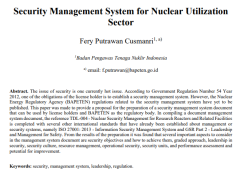
Security Management System for Nuclear Utilization Sector | Prosiding SKN 2020
Dalam upaya memperkuat perlindungan terhadap pemanfaatan tenaga nuklir di Indonesia, Badan Pengawas Tenaga Nuklir (BAPETEN) mendorong penerapan Sistem Manajemen Keamanan Nuklir (SMKN) sebagai bagian penting dari regulasi keselamatan dan keamanan instalasi nuklir nasional. Inisiatif ini muncul seiring meningkatnya insiden keamanan nuklir global—tercatat 189 laporan insiden di 36 negara pada 20…
- Edisi
- Hal.101-107
- ISBN/ISSN
- 1412-3258
- Deskripsi Fisik
- 7p. : Illus. ; pdf
- Judul Seri
- SKN 2020 INNOVATIONS TO SUPPORT NUCLEAR SAFETY AND SECURITY FOR ADVANCED HUMAN RESOURCES AND EXCELLENT INDONESIA
- No. Panggil
- 621.483066 PUT S
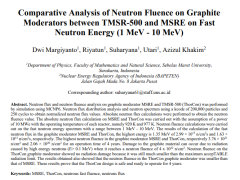
Comparative Analysis of Neutron Fluence on Graphite Moderators between TMSR-5…
Di tengah meningkatnya kebutuhan energi dunia dan keterbatasan sumber daya fosil, para peneliti Indonesia membawa kabar menggembirakan. Sebuah riset kolaborasi antara Universitas Sebelas Maret (UNS) dan Badan Pengawas Tenaga Nuklir (BAPETEN) membuktikan bahwa desain reaktor nuklir ThorCon TMSR-500 aman digunakan hingga empat tahun operasi penuh tanpa menimbulkan kerusakan material akibat radias…
- Edisi
- Hal.45-50
- ISBN/ISSN
- 1412-3258
- Deskripsi Fisik
- 6p. : Illus. ; pdf
- Judul Seri
- SKN 2020 INNOVATIONS TO SUPPORT NUCLEAR SAFETY AND SECURITY FOR ADVANCED HUMAN RESOURCES AND EXCELLENT INDONESIA
- No. Panggil
- 621.48 MAR C
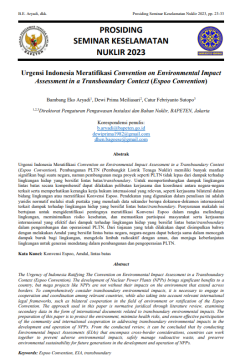
Urgensi Indonesia Meratifikasi Convention on Environmental Impact Assessment …
Urgensi Indonesia Meratifikasi Convention on Environmental Impact Assessment in a Transboundary Context (Espoo Convention). Pembangunan PLTN (Pembangkit Listrik Tenaga Nuklir) memiliki banyak manfaat signifikan bagi suatu negara, namun pembangunan mega proyek seperti PLTN tidak lepas dari dampak terhadap lingkungan hidup yang bersifat lintas batas/transboundary. Untuk mempertimbangkan dampak li…
- Edisi
- -
- ISBN/ISSN
- 1412-3258
- Deskripsi Fisik
- 11p. : Illus. ; pdf
- Judul Seri
- SKN 2023: Peningkatan Keselamatan dan Keamanan Instalasi Nuklir dan Sumber Radiasi Pengion untuk Mendukung Daya Saing Produk Nuklir dan Meningkatkan Kesejahteraan Masyarakat
- No. Panggil
- 344.046 EKO U

Development of Nuclear Security Detection Architecture Program Implementation…
Pemerintah Indonesia melalui Badan Pengawas Tenaga Nuklir (BAPETEN) mengumumkan rencana besar dalam memperkuat keamanan nuklir nasional dengan pemasangan 26 unit Radiation Portal Monitor (RPM) dan 113 unit Personal Radiation Detector (PRD) di berbagai pelabuhan dan bandara utama. Langkah ini dilakukan sebagai respons atas potensi ancaman penyelundupan zat radioaktif di wilayah kepulauan Indo…
- Edisi
- -
- ISBN/ISSN
- 1412-3258
- Deskripsi Fisik
- 9p. : Illus. ; pdf
- Judul Seri
- -
- No. Panggil
- 363.1799 HAD D
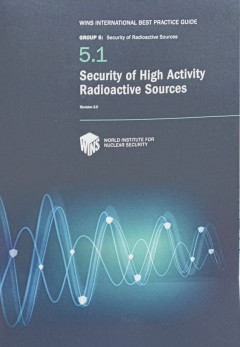
Security of High Activity Radioactive Source
Radioactive sources are used routinely by hospitals, research facilities and industry for such purposes as diagnosing and treating illnesses, sterilising equipment and inspecting welds. In countries with mature regulatory structures, the use of radioactive sources is highly regulated from a safety perspective. Licensees (authorised users) readily accept such regulations because they are well aw…
- Edisi
- -
- ISBN/ISSN
- 978-3-903031-82-1
- Deskripsi Fisik
- 33 p. : iilus. ; 29.5 cm.
- Judul Seri
- -
- No. Panggil
- 621.48 WIN S
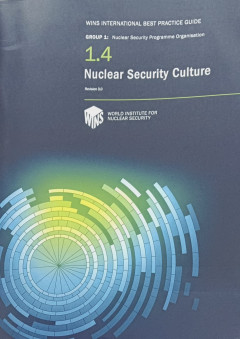
Nuclear Security Culture
Experience in a wide range of organisations entrusted with the security of sensitive materials strongly indicates that pervasive culture of security-as much as a robust security infrastructure-is essential to successfully lowering the risks associated with insider and external threats. This WINS International Best Practice Guide explains what nuclear security culture is, how it is created, and …
- Edisi
- -
- ISBN/ISSN
- 978-3-903031-80-7
- Deskripsi Fisik
- 37 p. : illus. ; 29.5 cm.
- Judul Seri
- -
- No. Panggil
- 621.48 WIN N
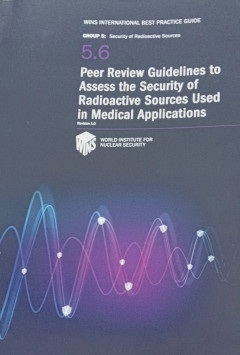
Peer Review Guidelines to Assess the Security of Radioactive Sources Used in …
Although radioactive sources are used around the world for multiple health purposes, they have the potential to cause significant harm if they fall into the wrong hands. A serious security event involving such sources could open a health care facility (HCP) to legal and economic liabilities; injure personnel, patients and members of the public; damage the environment; create widespread fear, pa…
- Edisi
- -
- ISBN/ISSN
- 978-3--903191-05-1
- Deskripsi Fisik
- 29 p. : illus. ; 29.5 cm.
- Judul Seri
- -
- No. Panggil
- 621.48 WIN P
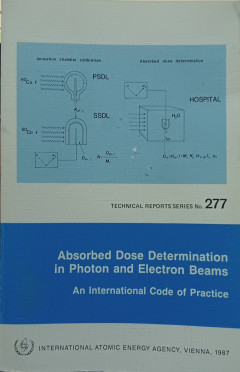
Technical Reports Series No. 277. Absorbed Dose Determination in Photon and E…
The published version of the newest Code of Practice, Absorbed Dose Determination in External Beam Radiotherapy: An International Code of Practice for Dosimetry based on Standards of Absorbed Dose to Water (TRS-398) .A link to the worksheets is provided at the bottom of this page. The development of primary standards of absorbed dose to water for high-energy photons and electrons offers the …
- Edisi
- -
- ISBN/ISSN
- 92-0-115087-3
- Deskripsi Fisik
- 98p. : Illus. ; pdf
- Judul Seri
- -
- No. Panggil
- 621.483 IAE T
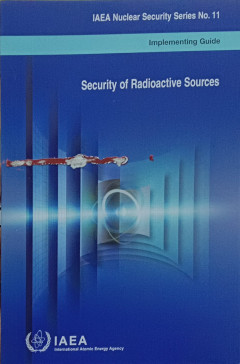
Security of Radioactive Sources | IAEA Nuclear Security Series No. 11
There are concerns that terrorist or criminal groups could gain access to high activity radioactive sources and use these sources maliciously. The IAEA is working with Member States to increase control, accounting and security of radioactive sources to prevent their malicious use and the associated potential consequences. Based on extensive input from technical and legal experts, this Implement…
- Edisi
- -
- ISBN/ISSN
- 92-0-111406-0
- Deskripsi Fisik
- 66p;illus.;24cm.
- Judul Seri
- -
- No. Panggil
- 621.48 IAE S
 Karya Umum
Karya Umum  Filsafat
Filsafat  Agama
Agama  Ilmu-ilmu Sosial
Ilmu-ilmu Sosial  Bahasa
Bahasa  Ilmu-ilmu Murni
Ilmu-ilmu Murni  Ilmu-ilmu Terapan
Ilmu-ilmu Terapan  Kesenian, Hiburan, dan Olahraga
Kesenian, Hiburan, dan Olahraga  Kesusastraan
Kesusastraan  Geografi dan Sejarah
Geografi dan Sejarah